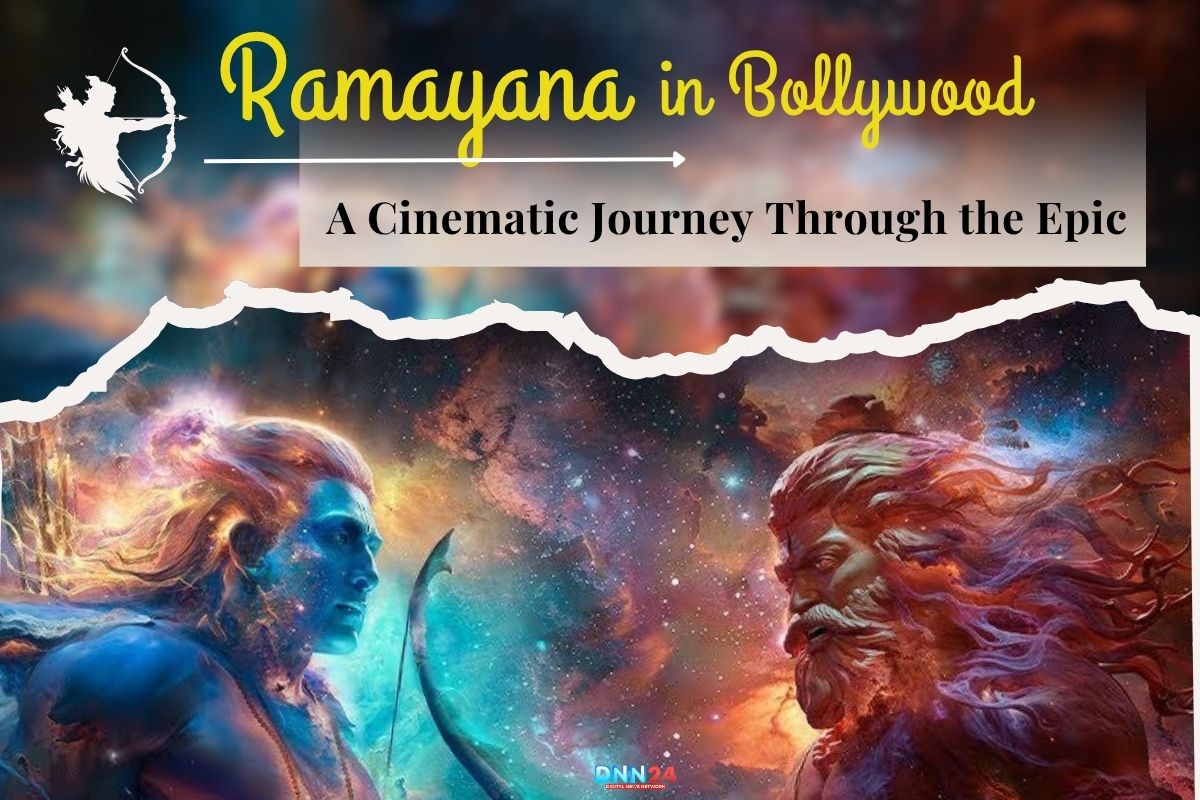The Ramayana, one of the most revered Sanskrit epics of ancient India, has been a cornerstone of Indian storytelling for centuries. Its storyline, which is about the life of Lord Ram, his wife Sita, and his devoted brother Lakshman, has enthused generations with the values of duty, sacrifice, and the victory of good over evil.
In the world of Indian cinema, the Ramayana has enjoyed an extraordinary journey. It has been adapted more than 25 times for film and over 14 times for television, making it one of the most frequently adapted works in Indian filmmaking history. From the silent era, with Dadasaheb Phalke’s Lanka Dahan (1917), to black-and-white classics and colourful modern retellings, filmmakers have continually found new ways to bring this epic to life.
Not only have these adaptations echoed down the Indian cinema in terms of tastes and technologies of Indian cinema, but they have also echoed down the social and cultural ways of the country.
Television Adaptations: Landmark Television Productions
The most iconic adaptation of the Ramayana for television is undoubtedly Ramanand Sagar’s Ramayan (1987), which became a cultural phenomenon in India. Telecast on Doordarshan, this serial introduced the ancient epic to the living rooms of millions of people, getting the whole family and community sitting in front of their television sets every Sunday morning. Production was a mammoth affair, as there were elaborate sets created in Umbergaon and a thorough casting procedure that saw more than 100 actors being auditioned till Arun Govil was finally chosen to play the role of Lord Ram. Sita (Deepika Chikhalia) was selected out of 400 applicants, and the costumes were created by Bhanu Athaiya, India’s first Oscar winner for Best Costume Design.
On average, each episode lasted a week, and it took two years of strong work to create the series. The final product of making the series is marked with its effectiveness and authenticity in execution, blazing novel standards in mythological storytelling on Indian television. This was so significant in that even the streets used to be deserted when it was on air, and the actors also became one catapulting to become the gods.
The popularity of Sagar’s Ramayan led to the creation of many more adaptations of the Ramayan, both animated and by contemporary retellings. However, none of them have rivalled the Ramayan in terms of audience effect. The series not only popularised the story in new generations, but it also made television a tool of delivering Indian sacred narratives to the masses without distinguishing it as entertainment or an experience of spirituality.
Notable Bollywood Film Adaptations of Ramayana
Bollywood has a rich history of adapting the Ramayana, both directly and through films inspired by its themes. Some of the earliest and most significant adaptations include Ram Rajya (1943), Sampoorna Ramayana (1961), and Lanka Dahan (1917). These movies became the paradigm of Indian mythology films, both in terms of overwhelming set design, music, and emphasis on ethics. Decades went by, and the filmmakers tried out new interpretations, returning to the story as it would be once again and retelling it as an allegory about the problems of modern society.
For instance, Suraj Barjatya’s Hum Saath Saath Hain (1999) is a modern family drama that draws heavily on the themes of familial duty and exile, paralleling Ram’s journey. More recently, films like Adipurush (2023) have attempted to reinterpret the epic for new audiences, though not always without controversy. The sheer number of adaptations—over many films and countless partial or inspired works—demonstrates Bollywood’s fascination with the Ramayana’s narrative depth and its potential for cinematic exploration. Each adaptation reflects the era in which it was made, from the devotional tone of early films to the special-effects-driven spectacles of today, ensuring that the Ramayana remains a living, evolving story in Indian cinema.
Cultural and Social Impact
The Ramayana’s adaptations in Bollywood and on television have had a profound cultural and social impact on Indian society. These retellings have strengthened moral values, formed collective memory, and offered a common cultural signifier to millions of people. The 1987 TV show was the uniting force as representatives of all strata of the population united to watch one of the shows, and in fact, that might be called a ritual in some religious way. The actors turned into household names, and their depiction set an example of how generations see the image of Ram, Sita, and Hanuman.
Bollywood films based on the Ramayana have also played a significant role in promoting family values, duty, and righteousness, often serving as moral compasses for their audiences. Themes of the epic have been embedded into Indian society and have shaped the literature, art, and politics.
Bollywood version and TV adaptation of Ramayan: A Tale Retold Numerous Times
The Ramayana has been adapted countless times in both Bollywood and the Indian television industry, each version bringing its interpretation and flavour to the timeless epic. Every adaptation contains within it the development in technological means, a change in culture, and the artistic feel of the time.
Television adaptations, especially Ramanand Sagar’s Ramayan (1987), set a benchmark for mythological storytelling, combining authenticity with mass appeal. In recent years, filmmakers have attempted to reimagine the epic using modern technology and new perspectives, as seen in Adipurush (2023) and the upcoming Ramayan (2025) by Nitesh Tiwari. Despite the numerous adaptations, the core story remains unchanged, highlighting the enduring power of the Ramayana to captivate audiences across generations.
What Makes Ramayan 2025 by Nitesh Tiwari Different from Other Adaptations of Ramayan?
Ramayana 2025 by Nitesh Tiwari is perhaps the greatest and technically ambitious adaptation of the epic in Indian cinema made so far. In contrast to the earlier incarnations, which were generally limited by budget and technology constraints, Tiwari is making her project on a truly epic scale, with visual effects being state-of-the-art in Oscar-winning DNEG and with a worldwide release strategy in mind.
The movie will be a two-part live-action saga and will be filmed in IMAX. It is aimed at the global market, with a vision to project the Indian cultural heritage on the international platform. The cast features some of India’s biggest stars, including Ranbir Kapoor as Rama, Yash as Ravana (also co-producer), Sai Pallavi as Sita, and Sunny Deol as Hanuman, ensuring both star power and acting prowess.
The film has been geared towards a blend of the authentic sense of mythology, coupled with contemporary aspects of cinematic art, so that there is a chance to find something emotional and breathtaking in terms of a visual effect. Unveiling the first peek, which is being heralded with screenings in nine Indian cities along with a giant billboard in Times Square, New York, points to the blockbuster ambitions of the entertainer.
As producer Namit Malhotra has stressed the importance behind the production, this is not merely an attempt to retell the story but also to present the customs and traditions of India to the world. The epic nature, technology, and global outlook of Ramayan 2025 distinguish it among all other adaptations and make it an epic project in the history of Indian films.
Problems and prospects
Adapting the Ramayana for modern cinema presents several unique challenges. Epic in its cultural and religious importance, the filmmaker takes a cautious step not to be controversial or hurtful. Being authentic and innovative is always treacherous because they have to hit both the mark of remaining true to what they are adopting and being creative to render a newness in perspective. On the one hand, the help of more advanced technology gives new opportunities in the visual narration; on the other hand, it creates some higher demands in the level of quality and realism.
Previous attempts at modernising the Ramayana, such as Adipurush (2023), have faced criticism for their interpretation and execution, highlighting the risks involved in reimagining such a revered narrative. The future of Ramayana adaptations in Bollywood will likely depend on the industry’s ability to harness new technologies, attract top talent, and engage global audiences while respecting the epic’s roots.
The planned project, such as Ramayan 2025, is an ambitious initiative that also indicates the readiness to make high-quality productions and compete at an international level. When done successfully, such endeavors could open the world to more mythological movies, with India taking a commanding position in the epic storytelling paradigm.
Contemporary Interpretations and Problems
Modern interpretations of the Ramayana in Bollywood have often sought to reinterpret the epic’s characters and themes to reflect contemporary values and sensibilities. Films like Raavan (2010) and Adipurush (2023) have experimented with narrative structure, character motivation, and visual style, sometimes drawing criticism for straying too far from tradition.
It is a delicate task to strike a balance between keeping the source material relevant and adapting it so that it can be presentable and relatable to the current generation. Moviemakers have to go through the maze of having to address issues of gender representation, cultural sensitivity, and the demands of a globalised audience that has become diverse.
Expensive visual effects and international production values, e.g., with the film Ramayan 2025, have opened up new possibilities of creative expression but have posed a greater challenge to success. Ultimately, the future of Ramayana adaptations will depend on the industry’s ability to innovate while maintaining respect for the epic’s enduring legacy, ensuring that the story continues to inspire and resonate with audiences for generations to come.
Ramayan 2025: Would Bollywood at last be on the correct track?
Through the release of Ramayan 2025, there is a renewed hope that Bollywood will finally provide a definitive piece of cinematic work based on the epic that is acceptable both to traditionalists and to the modern crowd. The unseen size of the film, the presence of A-list celebrities, and modern technology make the project a possible game-changer among the films of the mythological genre. Top talents on and off screen combine to indicate a promise of quality and respect for authenticity that has not always been in earlier versions.
The global release strategy and focus on emotional storytelling indicate an ambition to make the Ramayana accessible to a worldwide audience, showcasing India’s rich cultural heritage on an international stage. Nonetheless, Ramayan 2025 will only live up to its reputation when its spectacle meets substance, when it pays tribute to the spiritual power of the epic, and when it connects with fans of different generations. Should it do so, it would become a new example of mythological films in Bollywood, where a new generation of filmmakers will be inspired to treat ancient tales of India with love and imagination.
Also Read: Maa (2025) : Kajol’s Fierce Turn in a Mythological Horror Like No Other
You can connect with DNN24 on Facebook, Twitter, and Instagram and subscribe to our YouTube channel.

